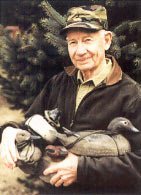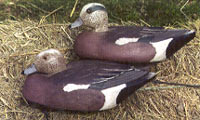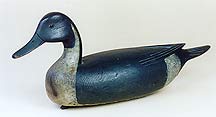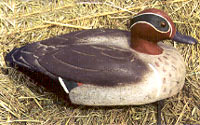by Larry Thomforde
 Back in the early 1970s my young family enjoyed camping vacations. On one such trip to the headwaters of the Mississippi River in Minnesota’s Itasca State Park, I drove around the area looking to purchase decoys for my fledgling collection. At an “off the beaten path” resort I noticed an unpainted wooden duck head with wonderful conformation and precise details in a small maintenance shed. The resort’s owner related that one of his guests, a fellow named Arnold Krueger from Owatonna, gave it to him in exchange for a tip on where the fish were biting. “I have one of his decoys up in the office,” he said, “but it’s not for sale.” Back in the early 1970s my young family enjoyed camping vacations. On one such trip to the headwaters of the Mississippi River in Minnesota’s Itasca State Park, I drove around the area looking to purchase decoys for my fledgling collection. At an “off the beaten path” resort I noticed an unpainted wooden duck head with wonderful conformation and precise details in a small maintenance shed. The resort’s owner related that one of his guests, a fellow named Arnold Krueger from Owatonna, gave it to him in exchange for a tip on where the fish were biting. “I have one of his decoys up in the office,” he said, “but it’s not for sale.”
Later that summer I drove to Owatonna and found Arnie more than willing to talk about decoys and duck hunting. He was so gracious it was even hard to feel frustrated that none of the decoys were for sale. But he offered, “Pick out one you like and put your name on the bottom. When I’m done hunting, I’ll give you a call.” I refused, certain the continued use would wash the ink away.
Annual visits revealed that Krueger was not only a gifted carver and painter of decoys, but also a talented violinist who performed at various occasions. His sensitivity to sounds, sights, color and detail provided the basis for his artistic personality, and as a music teacher in his hometown he shared these abilities with students for 50 years. His retirement was “picture perfect,” with the school district allowing him to gradually cut back on his teaching responsibilities. For Arnie and his students, it was mutually rewarding, and he taught part time for ten additional years.
 An inspection of Krueger’s childhood reveals many influences that likely formed his artistic inclinations and his love of music and waterfowl. Born and raised in Aberdeen, South Dakota, Arnie had ample opportunity to witness the tremendous flocks of mallards that fed in the cornfields each fall. His father took him hunting as soon as he was old enough to shoulder a shotgun. The sights, sounds and smells of hunting – and the resulting emotions – provide some of his earliest memories. His preteen years were spent back and forth between his home and his grandmother’s farm outside of town. Each summer he kept a pen of ducks and chickens that provided him with hours of entertainment and up-close observation of their habits. An inspection of Krueger’s childhood reveals many influences that likely formed his artistic inclinations and his love of music and waterfowl. Born and raised in Aberdeen, South Dakota, Arnie had ample opportunity to witness the tremendous flocks of mallards that fed in the cornfields each fall. His father took him hunting as soon as he was old enough to shoulder a shotgun. The sights, sounds and smells of hunting – and the resulting emotions – provide some of his earliest memories. His preteen years were spent back and forth between his home and his grandmother’s farm outside of town. Each summer he kept a pen of ducks and chickens that provided him with hours of entertainment and up-close observation of their habits.
Krueger’s inclination for music likely stemmed from his mother, who convinced him to take singing lessons when he was six-years-old. When he was in seventh grade an aunt died, and the family inherited a piano. His mother promptly signed him up for piano lessons. When Arnie was in ninth grade, his grandmother left him his grandfather’s violin. A musician in the making, Krueger graduated from Northern State Teachers College in 1950 with a bachelor’s degree in – what else – music. While teaching music in Owatonna in the 1950s he became hunting partners with Barney Anderson, the art teacher. In 1965, after gunning together for about 10 years, Arnie asked his friend to teach him how to make hunting decoys. For the next 15 years, starting a couple months before the opening of the waterfowl season, he would carve and paint a few decoys and add them to his rig. Krueger made bluebills, wood ducks, ringnecks, wigeon, buffleheads and blue and green-winged teal. He carved a few other species that were made for friends. He also carved some wax canvasback heads to use as molds for bronze castings. The Delta Waterfowl Research Station later used them as gifts to financial supporters.
Lothar Meisel, a 9th generation German violinmaker and friend, taught Arnie how to make knives for carving. Using basswood for the bodies and pine for the heads he fashioned his hollow birds with precise detail. From the overall conformation of the decoys to the intricate carving of the bills and primary feathers, Krueger was driven by an artistic force that was fed by the knowledge gained from years of waterfowl observation.
 Driven by a desire to carve superior decoys, Krueger attended the International Decoy Carving Contest held each year at the Mississippi Valley Fair in Davenport, Iowa. Always a spectator, he never competed. Owen Gromme, a renowned artist and ornithologist, was one of the judges of the competition, and along with others provided Arnie an opportunity to study and discuss the fine points of the art – what separates a good decoy from a great decoy. Today Krueger feels this could have been a mistake, for his resulting devotion to perfection made the process too time consuming, tedious with so many details. Wildlife artist David Maass, Arnie’s hunting partner of 40 years, encouraged him to continue making decoys to add to his rig. Driven by a desire to carve superior decoys, Krueger attended the International Decoy Carving Contest held each year at the Mississippi Valley Fair in Davenport, Iowa. Always a spectator, he never competed. Owen Gromme, a renowned artist and ornithologist, was one of the judges of the competition, and along with others provided Arnie an opportunity to study and discuss the fine points of the art – what separates a good decoy from a great decoy. Today Krueger feels this could have been a mistake, for his resulting devotion to perfection made the process too time consuming, tedious with so many details. Wildlife artist David Maass, Arnie’s hunting partner of 40 years, encouraged him to continue making decoys to add to his rig.
But in 1980, due to numerous factors, Krueger set aside the tools of his decoy-making trade. Perhaps most time-consuming was the purchase of a 230-acre piece of farmland – complete with a 45-acre slough and several adjacent ponds – that he restored to prime waterfowl habitat. He also put up 52 wood duck boxes near his house and started gathering data of wood duck biology and behavior. For the past ten years he has compiled a daily log regarding dates of nest initiation, the day each egg was laid, when the hen began incubation and the date the young left the nest. This is coupled with data regarding the number of eggs hatched, predation of eggs, nest abandonment and other notes of interest. Recently Krueger has added video cameras in the nest boxes to record behavior of both the hen and the newly hatched ducklings. Some of this video was recently shown on ESPN’s “Outdoors with Ron and Raven.”
Krueger has also been concentrating on his professional musical career, which demands daily practice. He is currently playing in four orchestras, which require regular rehearsals, and on special occasions is accompanied by his wife Erlys on piano. Evidently there is only one way for Arnie to engage an issue – with exceptional energy, dedication, sensitivity and detail.
 Krueger has an outbuilding on his farm that serves as his art studio. A doorway separates the violin practice area from the decoy-carving workbench. Although winter, the heat was turned off in the room where he had fashioned his rig. A wooden box there held the tools and materials for decoy making, including knives, glass eyes and several heads that didn’t quite meet specifications. A mummified drake canvasback head, to be studied for details in a future carving, awaited his attention. As we reminisced about duck hunting and decoy making, he reminded me of his priorities. “My family is always first,” he said, “my violin is second, and ducks, decoys and hunting are third.” Krueger has an outbuilding on his farm that serves as his art studio. A doorway separates the violin practice area from the decoy-carving workbench. Although winter, the heat was turned off in the room where he had fashioned his rig. A wooden box there held the tools and materials for decoy making, including knives, glass eyes and several heads that didn’t quite meet specifications. A mummified drake canvasback head, to be studied for details in a future carving, awaited his attention. As we reminisced about duck hunting and decoy making, he reminded me of his priorities. “My family is always first,” he said, “my violin is second, and ducks, decoys and hunting are third.”
While his decoy making activities have ceased, Arnie still enjoys duck hunting each fall. And his decoys are still a significant part of that experience, making this collector realize that it may be years before his gunning rig is retired. Arnie Krueger is a jack of many trades – teacher, musician and decoy maker – and truly a master of them all.
For the complete story, please see the Nov./Dec. 2001 issue of Decoy Magazine.
Tidbits Main Index

|


